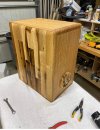Vineethkumar01
Well-Known Member
@captrajesh
I think you needn't worry too much about the published specs being closer or away from measured specs. I don't know much about the tolerances of Dayton. But still since this speaker in its kit form has been made available by experienced designers, they might have thought about the matter and might have made necessary leeway. Anyway, a few hertz to the above or below the actual tuning might not make much difference audibly.
I don't know this 'tuning by the ear' method. To me, the easiest way to check box tuning/alignment is to either make an impedance measurement and identify the rough minimum impedance point between the impedance peaks (in a bass reflex alignment) where the impedance phase also simultaneously goes to zero. REW can be used for it and an impedance jig can be made out of a few connectors and a dual channel sound card on a PC. https://www.roomeqwizard.com/help/help_en-GB/html/impedancemeasurement.html
Another more accurate method is to do a nearfield measurement of the driver in the box and identify the notch around the tuning frequency. For example in the attached pic here: https://www.hifivision.com/threads/audibility-of-port-resonances.85679/, around 38Hz is the bass reflex tuning frequency as shown by the deep notch around this frequency
Thanks
Vineeth
I think you needn't worry too much about the published specs being closer or away from measured specs. I don't know much about the tolerances of Dayton. But still since this speaker in its kit form has been made available by experienced designers, they might have thought about the matter and might have made necessary leeway. Anyway, a few hertz to the above or below the actual tuning might not make much difference audibly.
I don't know this 'tuning by the ear' method. To me, the easiest way to check box tuning/alignment is to either make an impedance measurement and identify the rough minimum impedance point between the impedance peaks (in a bass reflex alignment) where the impedance phase also simultaneously goes to zero. REW can be used for it and an impedance jig can be made out of a few connectors and a dual channel sound card on a PC. https://www.roomeqwizard.com/help/help_en-GB/html/impedancemeasurement.html
Another more accurate method is to do a nearfield measurement of the driver in the box and identify the notch around the tuning frequency. For example in the attached pic here: https://www.hifivision.com/threads/audibility-of-port-resonances.85679/, around 38Hz is the bass reflex tuning frequency as shown by the deep notch around this frequency
Thanks
Vineeth




